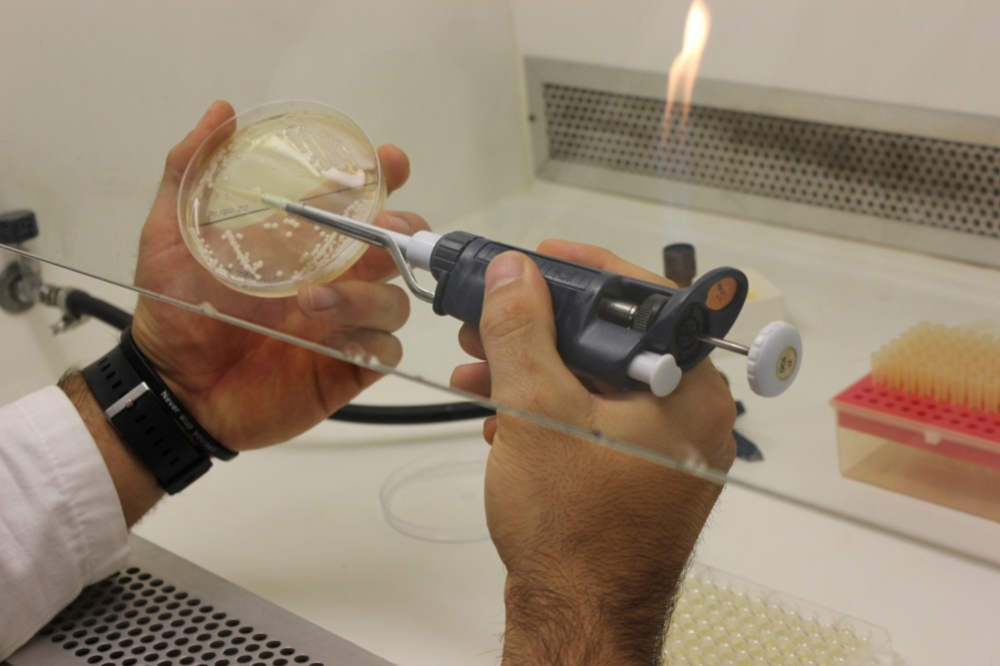


Researchers at the State University of Campinas have edited the genome of Saccharomyces cerevisiae, the brewer’s yeast used to produce ethanol, so that it converts xylose into xylitol. The strategy can add value to the ethanol industry and meet demand for a healthier sweetener (photo: Angélica Franceschini)
Published on 09/12/2022
By Julia Moióli | Agência FAPESP – Sugarcane straw, a low-cost biomass used to produce second-generation ethanol, can be turned into xylitol, a sugar of even higher value and economic interest. Through the action of modified brewer’s yeast, Saccharomyces cerevisiae, the xylose present in the material can be metabolized to produce xylitol, which is increasingly popular as a sweetener considered healthier than its main competitors. These are some of the findings of a study conducted at the State University of Campinas (UNICAMP) in São Paulo state, Brazil, and reported in an article published in the Journal of Genetic Engineering and Biotechnology.
“This potential is currently ignored by the ethanol industry, which fails to add value and meet growing demand from the market and food industry for xylitol as a sweetener,” said Fellipe da Silveira Bezerra de Mello, first author of the article. Mello is a researcher in the Genetics, Evolution, Microbiology and Immunology Department of the university’s Institute of Biology (IB-UNICAMP).
“The sweetness in xylitol is perceived as sugar by our brains, but the chemical has the advantage of not being metabolized by the intestines or fermented by the microorganisms that cause dental cavities, giving it huge potential on the world market,” said Gonçalo Amarante Guimarães Pereira, a professor at IB-UNICAMP and penultimate author of the article.
Gene editing
The study combined two research efforts. One involved the creation of a system for the genetic modification of Brazilian industrial lines of S. cerevisiae. Brewer’s yeast converts glucose into ethanol but does not metabolize xylose, a type of sugar available in sugarcane biomass (as well as trunks and leaves of other plants), so a mutant strain was developed by adding a gene to convert xylose into xylitol using CRISPR-Cas9 (Clustered Regularly Interspaced Short Palindromic Repeats with CRISPR-associated protein 9), a genome editing technique that precisely alters a specific DNA region. This is the first study to use the main lines of the yeast deployed by the Brazilian bioethanol industry and can serve as a basis for the work of other researchers.
The other research effort involved testing to confirm the possibility of using the same feedstock as in second-generation ethanol production – hydrolyzed sugarcane straw – to obtain xylitol. It also involved comparing production using two strains of the yeast edited in the same manner, one industrial and the other laboratory-based. Both strains were successful, but the industrial strain consistently outperformed the other.
“The results showed that Brazilian industrial yeast can produce more xylitol in the optimal medium, which contains only xylose, without all the stresses [impurities] of hydrolyzed sugarcane. The industrial strain also performed better at producing xylitol using hydrolyzed straw [with impurities], showing that this strain is also resistant to the stress present in the medium,” Mello said. “We conclusively demonstrated that Brazilian industrial yeast is not only very good for fermenting ethanol but also excellent for producing other molecules, in this case xylitol, which has more added value.”
Future research
Having completed the proof-of-concept stage, the researchers are now working on improvements to the productivity of the hydrolyzed sugarcane fermentation process. One of the strategies entails supplementing the culture medium to promote more yeast growth. Another is to apply an electrical current to the medium, which should contribute to the regeneration of co-factors, molecules that assist the chemical reactions required to convert xylose. The more co-factors there are, the more xylitol is produced.
“We’re sifting through the possible strategies to obtain a commercial product that's industrially competitive so that engineers can work on purifying the product for use by customers,” Mello said.
Participants in the studies included Carla Maneira, Frank Uriel Lizarazo Suarez, Sheila Nagamatsu, Beatriz Vargas, Carla Vieira, Thais Secches, Alessando L. V. Coradini, Maria Augusta de Carvalho Silvello, Rosana Goldbeck and Gleidson Silva Teixeira. The group was supported by FAPESP via three projects (15/06677-8, 18/03403-2 and 16/02506-7).
The article “Rational engineering of industrial S. cerevisiae: towards xylitol production from sugarcane straw” is at: jgeb.springeropen.com/articles/10.1186/s43141-022-00359-8.
Source: https://agencia.fapesp.br/39568